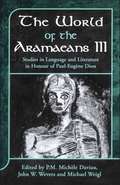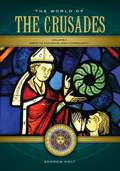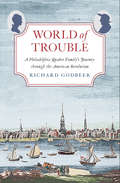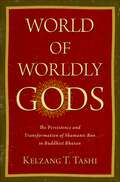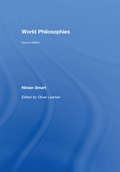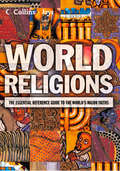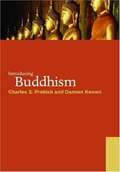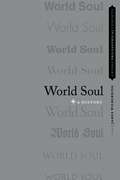- Table View
- List View
The World of the Aramaeans: Studies in Honour of Paul-Eugène Dion, Volume 3 (The Library of Hebrew Bible/Old Testament Studies)
by P.M. Michèle Daviau Michael Weigl John W. WeversThe World of the Aramaeans is a three-volume collection of definitive essays about the Aramaeans and the biblical world of which they were a part. Areas of interest include the language, epigraphy and history of the Aramaeans of Syria as well of their neighbours, the Israelites, Phoenicians, Ammonites, Moabites and Edomites. The third volume, on language and literature, includes essays by Michael Weigl, William Marrow, Grant Frame, James M. Lindenberger, Pierre Bordreuil, Amir Harrak, Theodore Lutz, Josef Tropper, Dennis Pardee and Clemens Leonhard.
The World of the Bahá'í Faith (Routledge Worlds)
by Robert H. StockmanThe World of the Bahá’í Faith is an outstanding guide to the Bahá’í Faith and its culture in all its geographical and historical diversity. Written by a distinguished team of international contributors, this volume explores the origin of this religion and contains substantial thematic articles on the living experience of the global Bahá’í community. The volume is organised into six distinct sections: Leadership and Authoritative Texts Theology Humanity Society The Contemporary Bahá’í Community History and Spread of the Bahá’í Community These sections cover such themes as the afterlife, artistic expression, Bahá’í institutions, devotional life, diversity, economics, education, the environment and sustainability, family life, gender, human nature, interfaith relations, international governance, law, marriage, peace, persecution, philosophy, race, science and religion, scripture, spirituality, and work. The development of the Bahá’í Faith is outlined in ten regional articles. This volume provides an authoritative and accessible source of information on all topics important to the Bahá’í Faith. The World of the Bahá’í Faith will be essential reading to students and scholars studying world religions and comparative religion. It will also be of interest to those in related fields such as sociology, political science, anthropology, and ethics.
The World of the Bahá'í Faith (Routledge Worlds)
by Robert H. StockmanThe World of the Bahá’í Faith is an outstanding guide to the Bahá’í Faith and its culture in all its geographical and historical diversity. Written by a distinguished team of international contributors, this volume explores the origin of this religion and contains substantial thematic articles on the living experience of the global Bahá’í community. The volume is organised into six distinct sections: Leadership and Authoritative Texts Theology Humanity Society The Contemporary Bahá’í Community History and Spread of the Bahá’í Community These sections cover such themes as the afterlife, artistic expression, Bahá’í institutions, devotional life, diversity, economics, education, the environment and sustainability, family life, gender, human nature, interfaith relations, international governance, law, marriage, peace, persecution, philosophy, race, science and religion, scripture, spirituality, and work. The development of the Bahá’í Faith is outlined in ten regional articles. This volume provides an authoritative and accessible source of information on all topics important to the Bahá’í Faith. The World of the Bahá’í Faith will be essential reading to students and scholars studying world religions and comparative religion. It will also be of interest to those in related fields such as sociology, political science, anthropology, and ethics.
The World of the Crusades [2 volumes]: A Daily Life Encyclopedia [2 volumes] (Daily Life Encyclopedias)
by Andrew HoltUnlike traditional references that recount political and military history, this encyclopedia includes entries on a wide range of aspects related to daily life during the medieval crusades.The medieval crusades were fundamental in shaping world history and provide background for the conflict that exists between the West and the Muslim world today. This two-volume set presents fundamental information about the medieval crusades as a movement and its ideological impact on both the crusaders and the peoples of the East. It takes a broad look at numerous topics related to crusading, with the goal of helping readers to better understand what inspired the crusaders, the hardships associated with crusading, and how crusading has influenced the development of cultures both in the East and the West.The first of the two thematically arranged volumes considers topics such as the arts, economics and work, food and drink, family and gender, and fashion and appearance. The second volume considers topics such as housing and community, politics and warfare, recreation and social customs, religion and beliefs, and science and technology. Within each topical section are alphabetically arranged reference entries, complete with cross-references and suggestions for further reading. Selections from primary source documents, each accompanied by an introductory headnote, give readers first-hand accounts of the crusades.
The World of the Crusades [2 volumes]: A Daily Life Encyclopedia [2 volumes] (Daily Life Encyclopedias)
by Andrew HoltUnlike traditional references that recount political and military history, this encyclopedia includes entries on a wide range of aspects related to daily life during the medieval crusades.The medieval crusades were fundamental in shaping world history and provide background for the conflict that exists between the West and the Muslim world today. This two-volume set presents fundamental information about the medieval crusades as a movement and its ideological impact on both the crusaders and the peoples of the East. It takes a broad look at numerous topics related to crusading, with the goal of helping readers to better understand what inspired the crusaders, the hardships associated with crusading, and how crusading has influenced the development of cultures both in the East and the West.The first of the two thematically arranged volumes considers topics such as the arts, economics and work, food and drink, family and gender, and fashion and appearance. The second volume considers topics such as housing and community, politics and warfare, recreation and social customs, religion and beliefs, and science and technology. Within each topical section are alphabetically arranged reference entries, complete with cross-references and suggestions for further reading. Selections from primary source documents, each accompanied by an introductory headnote, give readers first-hand accounts of the crusades.
World of Trouble: A Philadelphia Quaker Family's Journey through the American Revolution (The Lewis Walpole Series in Eighteenth-Century Culture and History)
by Richard GodbeerAn intimate account of the American Revolution as seen through the eyes of a Quaker pacifist couple living in Philadelphia Historian Richard Godbeer presents a richly layered and intimate account of the American Revolution as experienced by a Philadelphia Quaker couple, Elizabeth Drinker and the merchant Henry Drinker, who barely survived the unique perils that Quakers faced during that conflict. Spanning a half†‘century before, during, and after the war, this gripping narrative illuminates the Revolution’s darker side as patriots vilified, threatened, and in some cases killed pacifist Quakers as alleged enemies of the revolutionary cause. Amid chaos and danger, the Drinkers tried as best they could to keep their family and faith intact. Through one couple’s story, Godbeer opens a window on a uniquely turbulent period of American history, uncovers the domestic, social, and religious lives of Quakers in the late eighteenth century, and situates their experience in the context of transatlantic culture and trade. A master storyteller takes his readers on a moving journey they will never forget.
World of Wonders: The Work of Adbhutarasa in the Mahabharata and the Harivamsa
by Alf HiltebeitelIn World of Wonders, Alf Hiltebeitel addresses the Mahabharata and its supplement, the Harivamsa, as a single literary composition. Looking at the work through the critical lens of the Indian aesthetic theory of rasa, "juice, essence, or taste," he argues that the dominant rasa of these two texts is adbhutarasa, the "mood of wonder." While the Mahabharata signposts whole units of the text as "wondrous" in its table of contents, the Harivamsa foregrounds a stepped-up term for wonder (ascarya) that drives home the point that Vishnu and Krishna are one. Two scholars of the 9th and 10th centuries, Anandavardhana and Abhinavagupta, identified the Mahabharata's dominant rasa as santarasa, the "mood of peace." This has traditionally been received as the only serious contestant for a rasic interpretation of the epic. Hiltebeitel disputes both the positive claim that the santarasa interpretation is correct and the negative claim that adbhutarasa is a frivolous rasa that cannot sustain a major work. The heart of his argument is that the Mahabharata and Harivamsa both deploy the terms for "wonder" and "surprise" (vismaya) in significant numbers that extend into every facet of these heterogeneous texts, showing how adbhutarasa is at work in the rich and contrasting textual strategies which are integral to the structure of the two texts.
World of Wonders: The Work of Adbhutarasa in the Mahabharata and the Harivamsa
by Alf HiltebeitelIn World of Wonders, Alf Hiltebeitel addresses the Mahabharata and its supplement, the Harivamsa, as a single literary composition. Looking at the work through the critical lens of the Indian aesthetic theory of rasa, "juice, essence, or taste," he argues that the dominant rasa of these two texts is adbhutarasa, the "mood of wonder." While the Mahabharata signposts whole units of the text as "wondrous" in its table of contents, the Harivamsa foregrounds a stepped-up term for wonder (ascarya) that drives home the point that Vishnu and Krishna are one. Two scholars of the 9th and 10th centuries, Anandavardhana and Abhinavagupta, identified the Mahabharata's dominant rasa as santarasa, the "mood of peace." This has traditionally been received as the only serious contestant for a rasic interpretation of the epic. Hiltebeitel disputes both the positive claim that the santarasa interpretation is correct and the negative claim that adbhutarasa is a frivolous rasa that cannot sustain a major work. The heart of his argument is that the Mahabharata and Harivamsa both deploy the terms for "wonder" and "surprise" (vismaya) in significant numbers that extend into every facet of these heterogeneous texts, showing how adbhutarasa is at work in the rich and contrasting textual strategies which are integral to the structure of the two texts.
World of Worldly Gods: The Persistence and Transformation of Shamanic Bon in Buddhist Bhutan (AAR REFLECTION AND THEORY STU RELIGION)
by Kelzang T. TashiIn World of Worldly Gods, Kelzang T. Tashi offers the first comprehensive examination of the tenacity of Shamanic Bon practices, as they are lived and contested in the presence of an invalidating force: Buddhism. Through a rich ethnography of Goleng and nearby villages in central Bhutan, Tashi investigates why people, despite shifting contexts, continue to practice and engage with Bon, a religious practice that has survived over a millennium of impatience from a dominant Buddhist ecclesiastical structure. Against the backdrop of long-standing debates around practices unsystematically identified as 'bon', this book reframes the often stale and scholastic debates by providing a clear and succinct statement on how these practices should be conceived in the region. Tashi argues that the reasons for the tenacity of Bon practices and beliefs amid censures by the Buddhist priests are manifold and complex. While a significant reason for the persistence of Bon is the recency of formal Buddhist institutions in Goleng, he demonstrates that Bon beliefs are so deeply embedded in village social life that some Buddhists paradoxically feel it necessary to reach some kind of accommodation with Bon priests. Through an analysis of the relationship between Shamanic Bon and Buddhism, and the contemporary dynamics of Bhutanese society, this book tackles the longstanding concern of anthropology: cultural persistence and change. It discusses the mutual accommodation and attempted amalgamation of Buddhism and Bon, and offers fresh perspectives on the central distinguishing features of Great and Little Traditions.
World of Worldly Gods: The Persistence and Transformation of Shamanic Bon in Buddhist Bhutan (AAR REFLECTION AND THEORY STU RELIGION)
by Kelzang T. TashiIn World of Worldly Gods, Kelzang T. Tashi offers the first comprehensive examination of the tenacity of Shamanic Bon practices, as they are lived and contested in the presence of an invalidating force: Buddhism. Through a rich ethnography of Goleng and nearby villages in central Bhutan, Tashi investigates why people, despite shifting contexts, continue to practice and engage with Bon, a religious practice that has survived over a millennium of impatience from a dominant Buddhist ecclesiastical structure. Against the backdrop of long-standing debates around practices unsystematically identified as 'bon', this book reframes the often stale and scholastic debates by providing a clear and succinct statement on how these practices should be conceived in the region. Tashi argues that the reasons for the tenacity of Bon practices and beliefs amid censures by the Buddhist priests are manifold and complex. While a significant reason for the persistence of Bon is the recency of formal Buddhist institutions in Goleng, he demonstrates that Bon beliefs are so deeply embedded in village social life that some Buddhists paradoxically feel it necessary to reach some kind of accommodation with Bon priests. Through an analysis of the relationship between Shamanic Bon and Buddhism, and the contemporary dynamics of Bhutanese society, this book tackles the longstanding concern of anthropology: cultural persistence and change. It discusses the mutual accommodation and attempted amalgamation of Buddhism and Bon, and offers fresh perspectives on the central distinguishing features of Great and Little Traditions.
World Philosophies
by Ninian Smart Oliver LeamanWorld Philosophies presents in one volume a superb introduction to all the world’s major philosophical and religious traditions. Covering all corners of the globe, Ninian Smart’s work offers a comprehensive and global philosophical and religious picture. In this revised and expanded second edition, a team of distinguished scholars, assembled by the editor Oliver Leaman, have brought Ninian Smart’s masterpiece up to date for the twenty-first century. Chapters have been revised by experts in the field to include recent philosophical developments, and the book includes a new bibliographic guide to resources in world philosophies. A brand new introduction which celebrates the career and writings of Ninian Smart, and his contribution to the study of world religions, helps set the work in context.
World Philosophies
by Ninian Smart Oliver LeamanWorld Philosophies presents in one volume a superb introduction to all the world’s major philosophical and religious traditions. Covering all corners of the globe, Ninian Smart’s work offers a comprehensive and global philosophical and religious picture. In this revised and expanded second edition, a team of distinguished scholars, assembled by the editor Oliver Leaman, have brought Ninian Smart’s masterpiece up to date for the twenty-first century. Chapters have been revised by experts in the field to include recent philosophical developments, and the book includes a new bibliographic guide to resources in world philosophies. A brand new introduction which celebrates the career and writings of Ninian Smart, and his contribution to the study of world religions, helps set the work in context.
World Religions: The Esential Reference Guide To The World's Major Faiths (Collins Keys)
by CollinsA compact and informative guide to the key tenets, rituals and history of the world’s major faiths, now in a new easy-reference format.
World Religions: An Introduction for Students
by Jeaneane D. FowlerThis book provides an accessible introduction to the world religions of Judaism, Christianity, Islam, Hinduism, Buddhism, Sikhism and Taoism.
World Religions: Introducing Buddhism (PDF)
by Charles S. PrebishIntroducing Buddhism is the ideal resource for all students beginning the study of this fascinating religion. Charles S. Prebish and Damien Keown, two of today's leading Buddhist scholars, explain the key teachings of Buddhism, and trace the historical development and spread of the religion from its beginnings down to the present day. A chapter is devoted to each of the major regions where Buddhism has flourished: India, South East Asia, East Asia and Tibet. In addition to this regional focus, the introduction takes contemporary concerns into account, covering important and relevant topics such as Engaged Buddhism, Buddhist Ethics and Buddhism and the Western World, as well as a chapter devoted to Meditation.
World Religions for Healthcare Professionals
by Mark F. Carr Siroj Sorajjakool Ernest J. BurseyThis third edition of a popular text introduces healthcare students and professionals to a wide range of health beliefs and practices in world religions. Chapters on various religions are written to offer an insider’s view on the religion’s historical development, key beliefs and practices, including ideas of health, sickness, death, and dying. The chapters include case studies, advice on what to do and what to avoid when caring for patients. Introductory chapters invite the reader to consider the broad context of patient care in pluralistic society and explore one’s personal orientation to others from different religions. How we care for patients from different backgrounds and cultures insists on professional boundaries that the reader may have not yet examined. A new chapter explores the relationship between religion and public health in light of the COVID-19 pandemic, asking the reader to consider what morally appropriate balance is required if and when personal faith conflict with public health needs. Undoubtedly, the sensitivity with which clinicians communicate with patients and make decisions regarding appropriate medical intervention can be greatly increased by an understanding of religious and cultural diversity. This is a core textbook for students studying healthcare, religion and culture, and an invaluable reference for healthcare professionals.
World Religions for Healthcare Professionals
This third edition of a popular text introduces healthcare students and professionals to a wide range of health beliefs and practices in world religions. Chapters on various religions are written to offer an insider’s view on the religion’s historical development, key beliefs and practices, including ideas of health, sickness, death, and dying. The chapters include case studies, advice on what to do and what to avoid when caring for patients. Introductory chapters invite the reader to consider the broad context of patient care in pluralistic society and explore one’s personal orientation to others from different religions. How we care for patients from different backgrounds and cultures insists on professional boundaries that the reader may have not yet examined. A new chapter explores the relationship between religion and public health in light of the COVID-19 pandemic, asking the reader to consider what morally appropriate balance is required if and when personal faith conflict with public health needs. Undoubtedly, the sensitivity with which clinicians communicate with patients and make decisions regarding appropriate medical intervention can be greatly increased by an understanding of religious and cultural diversity. This is a core textbook for students studying healthcare, religion and culture, and an invaluable reference for healthcare professionals.
World Religions in Practice: A Comparative Introduction
by Paul GwynneWorld Religions in Practice introduces five of the world's great religions – Hinduism, Buddhism, Judaism, Christianity, and Islam – and explores how they are lived and expressed in custom, ritual, and symbol. A major new textbook exploring the world's great religions through their customs, rituals and everyday practices – by focusing on this 'lived experience' it goes beyond many traditional introductions to religious studies Adopts a directly comparative approach to develop a greater understanding of the nature of religion Each chapter engages with an individual theme, such as birth, death, food, pilgrimage and ethics, to illustrate how religious practices are expressed Broadens students' understanding by offering an impartial discussion of the similarities and differences between each religion Includes chapter-by-chapter opening themes and summaries, and will be accompanied by a website at www.blackwellpublishing.com/gwynne featuring additional resources and study questions.
World Religions in Practice: A Comparative Introduction
by Paul GwynneA new and expanded edition of a highly successful textbook on world religions with a comparative approach which explores how six major religions are lived and expressed through their customs, rituals and everyday practices. A new edition of this major textbook, exploring the world's great religions through their customs, rituals and everyday practices by focusing on the 'lived experience' This comparative study is enriched and broadened with the inclusion of a sixth religion, Daoism Takes a thematic, comparative and practical approach; each chapter explores a series of key themes including birth, death, ethics, and worship across all six religions at each time Broadens students' understanding by offering an impartial discussion of the similarities and differences between each religion Includes an increased range of student-friendly features, designed to allow students to engage with each religion and extend their understanding
World Religions in Practice: A Comparative Introduction
by Paul GwynneA new and expanded edition of a highly successful textbook on world religions with a comparative approach which explores how six major religions are lived and expressed through their customs, rituals and everyday practices. A new edition of this major textbook, exploring the world's great religions through their customs, rituals and everyday practices by focusing on the 'lived experience' This comparative study is enriched and broadened with the inclusion of a sixth religion, Daoism Takes a thematic, comparative and practical approach; each chapter explores a series of key themes including birth, death, ethics, and worship across all six religions at each time Broadens students' understanding by offering an impartial discussion of the similarities and differences between each religion Includes an increased range of student-friendly features, designed to allow students to engage with each religion and extend their understanding
A World Religions Reader
by Ian S. Markham Christy Lohr SappA comprehensive and accessible textbook which explores the traditions and beliefs of the world’s living religions – the fully updated and revised new edition The World Religions Reader is an inclusive, student-friendly examination of the history, teaching, practices, and appeal of the world’s major religions. Covering both the fundamentals and complexities of each religious tradition, this popular textbook brings together significant texts from scriptures and scholars, as well as writings from philosophers and other significant thinkers throughout history. Students are provided with an introduction and overview of the tradition, taken through its primary texts, and presented with a text which seeks to persuade the student of the tradition’s merits. This new edition has been thoroughly updated to be even more accessible for students new to interreligious engagement and to reflect current trends and developments in religions worldwide. Every chapter opens with a substantial overview which orients the new student and then flows into a carefully chosen set of texts - a regular textbook is now combined with a Reader. New content examines areas such as the Rastafarian tradition, while revised chapters cover secular humanism and indigenous and emerging religious traditions. The methodology of the book focuses on an empathetic approach – representing each tradition from the perspective of a conventional adherent – enabling students to develop understanding of each tradition and appreciate similarities and differences in their most typical forms. Invites students to study each tradition from the perspective of a follower, aiming to understand why the tradition is popular and powerful Explores representative passages, world-views, rituals and institutions, ethical expressions and modern outlooks for each religion Features discussions of interfaith perspectives on the role of women in religious traditions and the impact of world events and politics on interfaith communication Encourages students to consider questions of truth, the relation of religion and society, and the changing nature of a tradition in the modern world Includes a complete set of pedagogical tools and instructor resources, including end-of-chapter fact sheets, topic summaries, key term sections, and essay and discussion questions The World Religions Reader, Fourth Edition is an ideal textbook for undergraduate and graduate courses in religion, especially for liberal arts and non-affiliated colleges, as well as general readers wishing to increase their knowledge of the world’s religious traditions.
A World Religions Reader (Wiley Desktop Editions Ser.)
by Ian S. Markham Christy Lohr SappA comprehensive and accessible textbook which explores the traditions and beliefs of the world’s living religions – the fully updated and revised new edition The World Religions Reader is an inclusive, student-friendly examination of the history, teaching, practices, and appeal of the world’s major religions. Covering both the fundamentals and complexities of each religious tradition, this popular textbook brings together significant texts from scriptures and scholars, as well as writings from philosophers and other significant thinkers throughout history. Students are provided with an introduction and overview of the tradition, taken through its primary texts, and presented with a text which seeks to persuade the student of the tradition’s merits. This new edition has been thoroughly updated to be even more accessible for students new to interreligious engagement and to reflect current trends and developments in religions worldwide. Every chapter opens with a substantial overview which orients the new student and then flows into a carefully chosen set of texts - a regular textbook is now combined with a Reader. New content examines areas such as the Rastafarian tradition, while revised chapters cover secular humanism and indigenous and emerging religious traditions. The methodology of the book focuses on an empathetic approach – representing each tradition from the perspective of a conventional adherent – enabling students to develop understanding of each tradition and appreciate similarities and differences in their most typical forms. Invites students to study each tradition from the perspective of a follower, aiming to understand why the tradition is popular and powerful Explores representative passages, world-views, rituals and institutions, ethical expressions and modern outlooks for each religion Features discussions of interfaith perspectives on the role of women in religious traditions and the impact of world events and politics on interfaith communication Encourages students to consider questions of truth, the relation of religion and society, and the changing nature of a tradition in the modern world Includes a complete set of pedagogical tools and instructor resources, including end-of-chapter fact sheets, topic summaries, key term sections, and essay and discussion questions The World Religions Reader, Fourth Edition is an ideal textbook for undergraduate and graduate courses in religion, especially for liberal arts and non-affiliated colleges, as well as general readers wishing to increase their knowledge of the world’s religious traditions.
The World Religions Speak on ”The Relevance of Religion in the Modern World” (World Academy of Art and Science)
by Finley P. DunneWorld Soul: A History (Oxford Philosophical Concepts)
by James WilberdingMany philosophers and scientists over the course of history have held that the world is alive. It has a soul, which governs it and binds it together. This suggestion, once so wide-spread, may strike many of us today as strange and antiquated--in fact, there are few other concepts that, on their face, so capture the sheer distance between us and our philosophical inheritance. But the idea of a world soul has held so strong a grip upon philosophers' imaginations for over 2,000 years, that it continues to underpin and even structure how we conceive of time and space. The concept of the world soul is difficult to understand in large part because over the course of history it has been invoked to very different ends and within the frameworks of very different ontologies and philosophical systems, with varying concepts of the world soul emerging as a result. This volume brings together eleven chapters by leading philosophers in their respective fields that collectively explore the various ways in which this concept has been understood and employed, covering the following philosophical areas: Platonism, Stoicism, Medieval, Indian or Vedântic, Kabbalah, Renaissance, Early Modern, German Romanticism, German Idealism, American Transcendentalism, and contemporary quantum mechanics and panpsychism theories. In addition, short reflections illuminate the impact the concept of the world soul has had on a small selection of areas outside of philosophy, such as harmony, the biological concept of spontaneous generation, Henry Purcell, psychoanalysis, and Gaia theories.
World Soul: A History (Oxford Philosophical Concepts)
Many philosophers and scientists over the course of history have held that the world is alive. It has a soul, which governs it and binds it together. This suggestion, once so wide-spread, may strike many of us today as strange and antiquated--in fact, there are few other concepts that, on their face, so capture the sheer distance between us and our philosophical inheritance. But the idea of a world soul has held so strong a grip upon philosophers' imaginations for over 2,000 years, that it continues to underpin and even structure how we conceive of time and space. The concept of the world soul is difficult to understand in large part because over the course of history it has been invoked to very different ends and within the frameworks of very different ontologies and philosophical systems, with varying concepts of the world soul emerging as a result. This volume brings together eleven chapters by leading philosophers in their respective fields that collectively explore the various ways in which this concept has been understood and employed, covering the following philosophical areas: Platonism, Stoicism, Medieval, Indian or Vedântic, Kabbalah, Renaissance, Early Modern, German Romanticism, German Idealism, American Transcendentalism, and contemporary quantum mechanics and panpsychism theories. In addition, short reflections illuminate the impact the concept of the world soul has had on a small selection of areas outside of philosophy, such as harmony, the biological concept of spontaneous generation, Henry Purcell, psychoanalysis, and Gaia theories.
